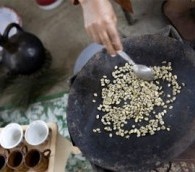Destination: Ethiopia
AFAR Goes to Coffeeland
by Eva Holland | 04.25.13 | 8:58 AM ET
In the latest AFAR, longtime World Hum contributor David Farley goes to the world’s caffeine heartland: Ethiopia. Here’s Farley:
Coffee is to Ethiopia what hops are to Bohemia or grapes to Bordeaux. That is, coffee is almost everything, from the cornerstone of the community’s economic fortunes to the lifeblood of its social relations. Java drinking is so deeply rooted here that Azeb was dumbstruck that I could have lived 40 years on the planet never having seen what coffee looks like before it’s plucked, peeled, dried, roasted, and ground.
Which is exactly why I was in Ethiopia. I wanted to travel around this East African country’s primary coffee-growing regions and immerse myself in its coffee culture. I can sit around at coffeehouses in New York and San Francisco drinking all the Ethiopian coffee my brain can take before spinning out of control. But I was curious about the time and toil it takes to produce these beans, everything that goes into slaking the States’ obsessive thirst for small-batch artisan roasts.
Headed to Coffeeland yourself? Check out our primer on how to take part in an Ethiopian coffee ceremony.
World Travel Watch: Drug Violence in Acapulco, iPad Ban in Israel and More
by Larry Habegger | 04.21.10 | 12:40 PM ET
Larry Habegger rounds up global travel news
How to Take Part in an Ethiopian Coffee Ceremony
by Jenny Dunlop | 03.09.10 | 11:10 AM ET
In Ethiopia, people who have no one to drink coffee with have no friends. Jenny Dunlop explains why you must stay for the third cup.
From the Times of London Archives: Thesiger in Ethiopia
by Eva Holland | 07.25.08 | 9:47 AM ET
Legendary travel writer Wilfred Thesiger waited more than 60 years before writing The Danakil Diary, a narrative about his Ethiopian travels in the early 1930s. At the time, though, he also wrote a handful of dispatches for the Times of London, and the Times travel section has posted those original articles as part of an ongoing series of “travel classics.” Keep an eye out for more travel content from the Times’ extensive digital vault. The section editor expects to post four or five vintage stories each month.
Related on World Hum:
* Top Travel Books: No. 1: “Arabian Sands” by Wilfred Thesiger
Axum Obelisk Returns to Ethiopia
by Eva Holland | 06.11.08 | 10:46 AM ET
In an extreme case of touristic vandalism—a very, very extreme case—the 1,700 year-old obelisk had been removed by occupying Italian troops in 1937. According to Agence France-Presse, it will be reassembled throughout the summer.
‘The Condé Nast Traveler Book of Unforgettable Journeys’
by Tyler D. Johnson | 10.05.07 | 10:23 AM ET
A new anthology gathers some of the most memorable stories from the magazine's 20-year history. Tyler D. Johnson says it contains the humor and wisdom only travel can deliver.
Harar: Islamic Holy City Turns to Tourism
by Joanna Kakissis | 09.24.07 | 12:36 PM ET
The ancient city of Harar in Ethiopia may suffer chronic water shortages and a lack of modern amenities, but regional politicians are hoping to transform this hilltop city, a UNESCO World Heritage site, into a popular getaway for tourists, writes Anita Powell of the AP. With its walled maze of ancient mosques and alleyways, Harar has enough mystique to stir the imagination of adventurous travelers. The fourth-holiest city in Islam, it’s a center of the faith in the Horn of Africa. The French poet Arthur Rimbaud lived there in the late 1800s, and his home is now an art gallery. Harar is also known as the birthplace of coffee; its scent lingers in the Ethiopian highlands. And it’s also got “an old man who hand-feeds some 50 hyenas every night, treating them like obedient kittens,” Powell writes.
Suffering and Smiling: Vanity Fair Does Africa
by Frank Bures | 06.27.07 | 11:31 AM ET
Africa is hot. Why? So we can save it? Frank Bures deconstructs the magazine's latest issue and what it says about Western views of the continent.
The Critics: ‘Bad Lands: A Tourist on the Axis of Evil’
by Michael Yessis | 04.24.07 | 10:57 AM ET
It’s not a new idea, visiting the countries U.S. President George W. Bush dubbed the “Axis of Evil.” Ben Anderson, for instance, did it several years ago, and the BBC broadcast several programs based on his travels. Now Lonely Planet founder Tony Wheeler has written “Bad Lands: A Tourist on the Axis of Evil,” in which he chronicles his travels through Bush’s original three “axis” countries—Iran, Iraq and North Korea—plus Afghanistan, Albania, Burma, Cuba, Libya and Saudi Arabia.
Spontaneous Trip to Somalia Leads to Three-Nation Ordeal for Swedish Couple
by Michael Yessis | 04.23.07 | 9:30 AM ET
‘Stalking the Wild Dik-Dik’: Going Solo Through Africa
by Frank Bures | 02.01.07 | 7:03 AM ET
From south to north, Marie Javins journeyed alone across the continent. Frank Bures reviews her chronicle of the trip and finds the author a likable travel companion.
Dallol, Ethiopia
by Ben Keene | 08.26.06 | 9:32 AM ET
Coordinates: 14 14 N 40 18 E
Elevation: -157 feet (-48 meters)
If avoiding the heat is your goal, then Death Valley, California—the hottest location in the United States—might be one spot to avoid in late August. Dallol, Ethiopia is another. A small settlement in the
state of Afar near the Eritrean border, Dallol holds the record for the highest average annual temperature for any inhabited place on the planet. In addition to plenty of sweltering sunshine, this part of the African continent also offers an opportunity to see the first signs of a new ocean basin forming. Not far from Dallol in the Danakil Depression north of the Great Rift Valley, the only volcanic crater below sea level has remained silent since 1926 as the seabed it will one day occupy gradually widens.
—.(JavaScript must be enabled to view this email address) is the editor of the Oxford Atlas of the World.
No. 1: “Arabian Sands” by Wilfred Thesiger
by Frank Bures | 05.31.06 | 12:14 PM ET
To mark our five-year anniversary, we’re counting down the top 30 travel books of all time, adding a new title each day this month.
Published: 1959
Territory covered: Ethiopia, Somalia, Sudan, Arabian Penninsula (now Yemen, Oman, Saudia Arabia, United Arab Emirates)
No. 22: “When the Going was Good” by Evelyn Waugh
by Frank Bures | 05.10.06 | 7:15 AM ET
To mark our five-year anniversary, we’re counting down the top 30 travel books of all time, adding a new title each day this month.
Published: 1947
Territory covered: Ethiopia, Yemen, East Africa, Guyana and Brazil
In the first part of the 20th century, Evelyn Waugh was one of a handful of bright young writers who headed off into the wild world to propel the genre of travel writing forward. “We turned our backs on civilization,” Waugh wrote of himself, Peter Fleming and Robert Byron, whose early death Waugh mourned. “From 1928 to 1937,” he wrote, “I had no fixed home and no possessions which would not conveniently go on a porter’s barrow. I traveled continuously, in England and abroad.” Armed with trunkloads of wit, an eye for characters and the cocksure attitude of the imperialist he was, Waugh headed to Ethiopia, Yemen, East Africa, Guyana and Brazil. The result was several travel books that went out of print. But the author pulled long excerpts from them, which were reprinted in When the Going was Good. Each is essentially a short travel book itself, including one about the coronation of Haile Selassie and Waugh’s attempt to travel from Guyana to Brazil. It all has a carefree feeling, as Waugh himself admitted. “I never aspired to be a great traveler,” he wrote, “I was simply a young man, typical of my age; we traveled as a matter of course. I rejoice that I went when the going was good.”
- « Prev Page
- Next Page »




